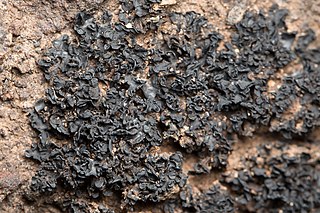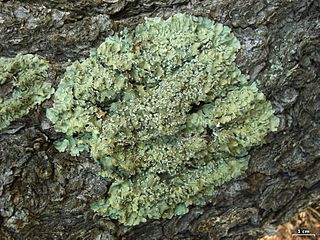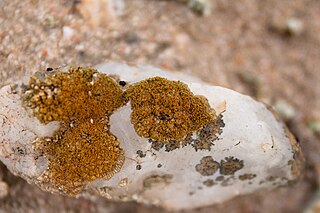
The Parmeliaceae is a large and diverse family of Lecanoromycetes. With over 2700 species in 71 genera, it is the largest family of lichen-forming fungi. The most speciose genera in the family are the well-known groups: Xanthoparmelia, Usnea, Parmotrema, and Hypotrachyna.

The Lecanorales are an order of mostly lichen-forming fungi belonging to the class Lecanoromycetes in the division Ascomycota. The order contains 26 families, 269 genera, and 5695 species.

The Lecanoraceae are a family of lichenized fungi in the order Lecanorales. Species of this family have a widespread distribution.

The Psoraceae are a family of lichenized fungi in the order Lecanorales. The Austrian Botanist and Lichenologist Alexander Zahlbruckner first described the family in 1898. Species of this family have a widespread distribution.

The Acarosporaceae are a family of fungi in the order Acarosporales. Members of this family have a widespread distribution, and are mostly lichenized with green algae. According to a 2021 estimate, the family contains 11 genera and about 260 species. The family is characterised by a hamathecium formed of paraphysoids.

The Lichinaceae are a family of ascomycete fungi. Most species are lichenized with cyanobacteria, and have a distribution largely in temperate regions.
Lithoglypha is a fungal genus in the family Acarosporaceae. It is monotypic, containing the single species Lithoglypha aggregata, a saxicolous (rock-dwelling), crustose lichen found in South Africa. Both the genus and species were proposed in 1988 by lichenologist Franklin Andrej Brusse in 1988. The genus name is derived from the Greek roots lithos ("rock") and glyphe. The lichen is only known to occur in the Clarens Formation of South Africa.
Santessonia is a genus of lichenized fungi in the family Caliciaceae. The genus was circumscribed in 1978 by lichenologists Mason Hale and Gernot Vobis, with Santessonia namibensis assigned as the type species, and at that time, only species. This species, endemic to the Namib Desert, has deep depressions (lacunae) in the thallus, which are interpreted as an adaptation to take advantage of the infrequent moisture provided by fog. The genus name honours Norwegian lichenologist Rolf Santesson.

Catapyrenium is a genus of lichens in the family Verrucariaceae. The genus was circumscribed by German botanist Julius von Flotow in 1850.

Flavopunctelia is a genus of foliose lichens in the family Parmeliaceae. The genus contains species that are widespread in temperate and tropical areas. The genus is characterised by broad, yellow-green lobes, point-like (punctiform) pseudocyphellae on the thallus surface, and bifusiform conidia. All species contain usnic acid as a major secondary chemical in the cortex. Flavopunctelia was originally conceived as a subgenus of Punctelia by Hildur Krog in 1982; Mason Hale promoted it to generic status in 1984.

Canoparmelia is a genus of lichen-forming fungi in the family Parmeliaceae. The widespread genus contains about 35 species. Canoparmelia, a segregate of the parmelioid lichen genus Pseudoparmelia, was circumscribed by John Elix and Mason Hale in 1986.

Peltula is a genus of small dark brown to olive or dark gray squamulose lichens that can be saxicolous ) or terricolous. Members of the genus are commonly called rock-olive lichens. They are cyanolichens, with the cyanobacterium photobiont from the genus Anacystis. They are umbilicate with flat to erect squamule lobes that attach from a central holdfast or cluster of rhizenes. Lichen spot tests are usually negative.
Eremastrella is a genus of lichen in the family Lecideaceae. The genus was circumscribed by lichenologist Stefan Vogel in 1955, with Eremastrella tobleri assigned as the type species.
Glyphopeltis is a genus in the family Psoraceae. It is monotypic, consisting of the single saxicolous lichen species Glyphopeltis eburina, found in southern Africa. This species was formally described as a new species in 1985 by Franklin Brusse, who discovered the type specimen growing on the shaded lower surface of a dolerite boulder in Cape Province.

The Lecideaceae are a family of lichens in the order Lecideales.
Catarrhospora is a genus of two species of lichens in the family Lecideaceae that are found in South Africa. The genus was circumscribed by lichenologist Franklin Andrej Brusse in 1994.
Coelopogon is a genus of lichen-forming fungi in the family Parmeliaceae. The genus contains two species found in southern South America and South Africa.

Thelenellaceae is a family of lichen-forming fungi. It is the sole family in the monotypic order Thelenellales, and contains three genera and about 50 species.

Stellarangia is a genus of lichen-forming fungi in the family Teloschistaceae. It has three species of saxicolous (rock-dwelling), crustose lichens. Species of Stellarangia are found in dry, desert areas in Namibia and South Africa.












